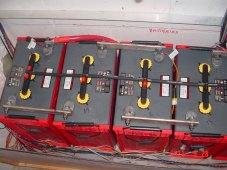HighTechLab
AKA Dexter - CTO of Current Connected, LLC
- Joined
- Sep 23, 2019
- Messages
- 1,761
As most everyone here knows, I love lithium...even started a company selling it! This however doesn't mean I haven't had my share of bad run ins with lead-acid. While I take every opportunity to ditch lead-acid, every single one of my vehicles still has one, and even my 1997 forklift that we use daily has one.
My concern for this thread is mainly for the forklift. We really can't get rid of the 5000 LB FLA battery, because Lithium is not heavy enough, and even if I filled the rest of the space with things like concrete, steel, etc. it still wouldn't be as heavy as the battery made of lead as the density of lead is much higher. We are sorta stuck for now.
Anyway, to the point now...Over on another thread I was reading a suggestion on watering - "Only add water to max level AFTER fully charged."
Is this true for all cases, not to add water until charging has completed? What's the logic here? I've always added water to this lift when I first put it on the charger, thinking the charge cycle (and bubbling throughout the process) mixes the fresh water throughout the cell. What's the best practice here and the reasoning?
My concern for this thread is mainly for the forklift. We really can't get rid of the 5000 LB FLA battery, because Lithium is not heavy enough, and even if I filled the rest of the space with things like concrete, steel, etc. it still wouldn't be as heavy as the battery made of lead as the density of lead is much higher. We are sorta stuck for now.
Anyway, to the point now...Over on another thread I was reading a suggestion on watering - "Only add water to max level AFTER fully charged."
Is this true for all cases, not to add water until charging has completed? What's the logic here? I've always added water to this lift when I first put it on the charger, thinking the charge cycle (and bubbling throughout the process) mixes the fresh water throughout the cell. What's the best practice here and the reasoning?




